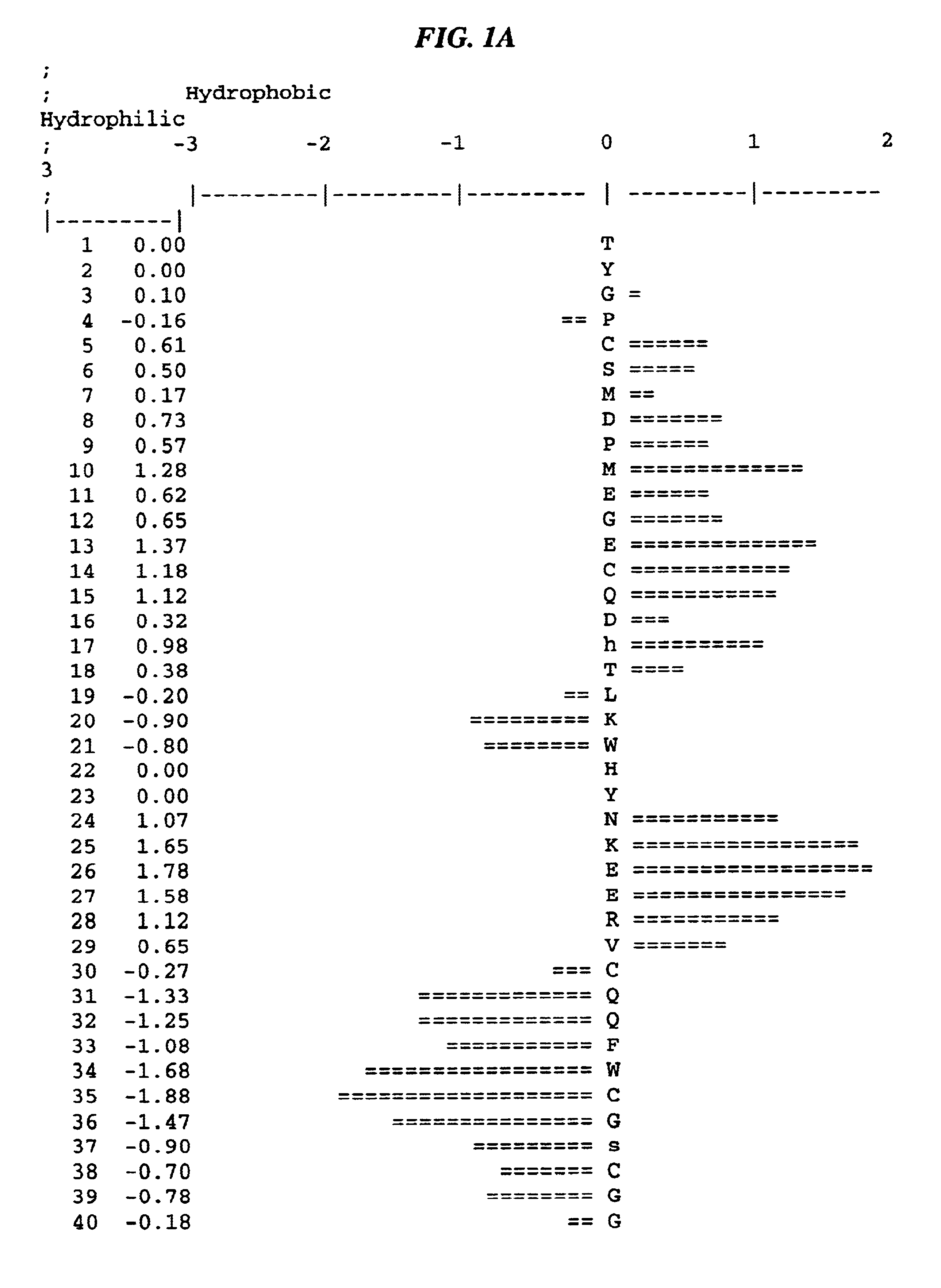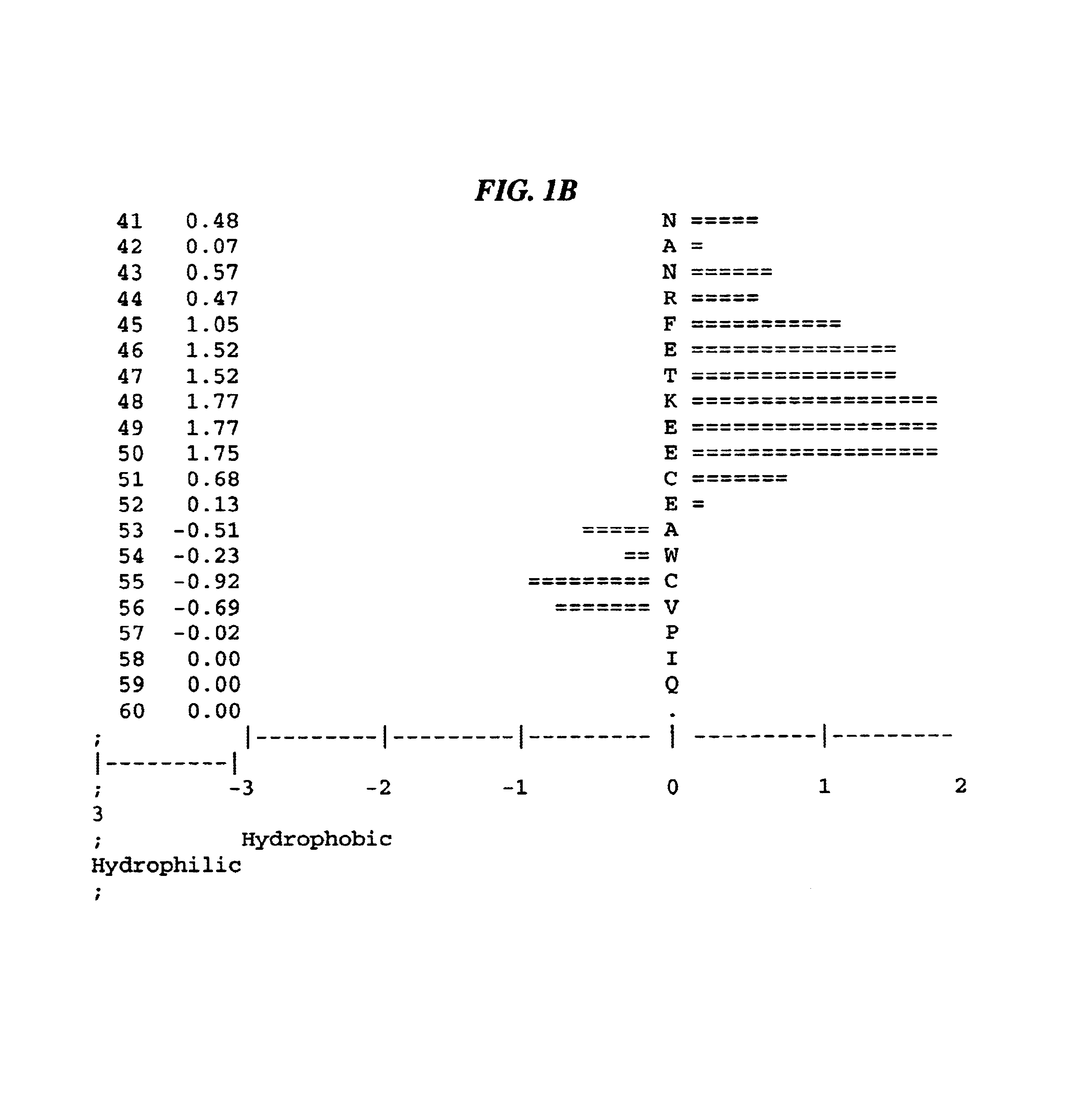Kunitz domain polypeptide zkun10
a polypeptide and domain technology, applied in the field of kunitz domain polypeptide zkun10, can solve the problems of low potency and lack of specificity of known kunitz-type inhibitors
- Summary
- Abstract
- Description
- Claims
- Application Information
AI Technical Summary
Problems solved by technology
Method used
Image
Examples
example 1
Cloning zkun10
[0128]To obtain a Zkun10 cDNA clone, cDNA is prepared from stomach using a a commercially available kit (Marathon™ cDNA Amplification Kit from Clontech Laboratories, Inc., Palo Alto, Calif.) and an oligo(dT) primer. To amplify the zkun10 DNA, 5 μl each of 1 / 100 diluted cDNAs, 20 pmoles each of two oligonucleotide primers designed from SEQ ID NO: 1, and 1 U of a 2:1 mixture of ExTaq™ DNA polymerase (TaKaRa Biomedicals) and Pfu DNA polymerasse (Stratagene, La Jolla, Calif.) (ExTaq / Pfu) are used in a 25-μl reaction mixture. The reaction mixture is incubated at 94° C. for 2 minutes; 25 cycles of 94° C. for 15 seconds, 66° C. for 20 s and 72° C. for 30 seconds; and a 1-minute incubation at 72° C. 1 μl each of 1 / 100 diluted first PCR product is used as template for a nested PCR. 20 pmoles each of two additional oligonucleotide primers and 1 U of ExTaq / Pfu are used in 25- μl reaction mixtures. The mixtures are incubated at 94° C. for 2 minutes; 2 cycles of 94° C. for 15 secon...
example 2
Expression of zkun10 in CHO cells
[0131]CHO DG44 cells (Chasin et al., Som. Cell. Molec. Genet. 12:555-666, 1986) are plated in 10-cm tissue culture dishes and allowed to grow to approximately 50% to 70% confluency overnight at 37° C., 5% CO2, in Ham's F12 / FBS media (Ham's F12 medium (Life Technologies), 5% fetal bovine serum (Hyclone, Logan, Utah), 1% L-glutamine (JRH Biosciences, Lenexa, Kans.), 1% sodium pyruvate (Life Technologies)). The cells are then transfected with the plasmid zkun10 / pZMP6 by liposome-mediated transfection using a 3:1 (w / w) liposome formulation of the polycationic lipid 2,3-dioleyloxy-N-[2(sperminecarboxamido)ethyl]-N,N-dimethyl-1-propaniminium-trifluoroacetate and the neutral lipid dioleoyl phosphatidylethanolamine in membrane-filetered water (Lipofectamine™ Reagent, Life Technologies), in serum free (SF) media formulation (Ham's F12, 10 mg / ml transferrin, 5 mg / ml insulin, 2 mg / ml fetuin, 1% L-glutamine and 1% sodium pyruvate). Zkun10 / pZMP6 is diluted into 1...
example 3
Expression of zkun10 in BHK cells
[0133]Full-length zkun10 protein is produced in BHK cells transfected with pZMP6 / zkun10 (Example 1). BHK 570 cells (ATCC CRL-10314) are plated in 10-cm tissue culture dishes and allowed to grow to approximately 50 to 70% confluence overnight at 37° C., 5% CO2, in DMEM / FBS media (DMEM, Gibco / BRL High Glucose; Life Technologies), 5% fetal bovine serum (Hyclone, Logan, Utah), 1 mM L-glutamine (JRH Biosciences, Lenexa, Kans.), 1 mM sodium pyruvate (Life Technologies). The cells are then transfected with pZMP6 / zkun10 by liposome-mediated transfection (using Lipofectamine™; Life Technologies), in serum free (SF) media (DMEM supplemented with 10 mg / ml transferrin, 5 mg / ml insulin, 2 mg / ml fetuin, 1% L-glutamine and 1% sodium pyruvate). The plasmid is diluted into 15-ml tubes to a total final volume of 640 μl with SF media. 35 μl of the lipid mixture is mixed with 605 μl of SF medium, and the resulting mixture is allowed to incubate approximately 30 minutes ...
PUM
| Property | Measurement | Unit |
|---|---|---|
| Inhibition | aaaaa | aaaaa |
Abstract
Description
Claims
Application Information
 Login to View More
Login to View More - R&D
- Intellectual Property
- Life Sciences
- Materials
- Tech Scout
- Unparalleled Data Quality
- Higher Quality Content
- 60% Fewer Hallucinations
Browse by: Latest US Patents, China's latest patents, Technical Efficacy Thesaurus, Application Domain, Technology Topic, Popular Technical Reports.
© 2025 PatSnap. All rights reserved.Legal|Privacy policy|Modern Slavery Act Transparency Statement|Sitemap|About US| Contact US: help@patsnap.com



